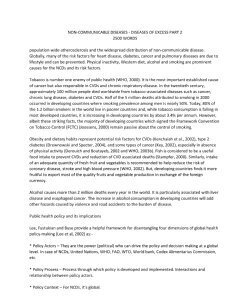NON-COMMUNICABLE DISEASES - DISEASES OF EXCESS PART population-wide atherosclerosis and the widespread distribution of non-communicable disease. Globally, many of the risk factors for heart22500 WORDS
NON-COMMUNICABLE DISEASES - DISEASES OF EXCESS PART population-wide atherosclerosis and the widespread distribution of non-communicable disease. Globally, many of the risk factors for heart22500 WORDS
NON-COMMUNICABLE DISEASES - DISEASES OF EXCESS PART 2
2500 WORDS
population-wide atherosclerosis and the widespread distribution of non-communicable disease. Globally, many of the risk factors for heart disease, diabetes, cancer and pulmonary diseases are due to lifestyle and can be prevented. Physical inactivity, Western diet, alcohol and smoking are prominent causes for the NCDs and its risk factors.
Tobacco is number one enemy of public health (WHO, 2000). It is the most important established cause of cancer but also responsible in CVDs and chronic respiratory disease. In the twentieth century, approximately 100 million people died worldwide from tobacco-associated diseases such as cancer, chronic lung disease, diabetes and CVDs. Half of the 5 million deaths attributed to smoking in 2000 occurred in developing countries where smoking prevalence among men is nearly 50%. Today, 80% of the 1.2 billion smokers in the world live in poorer countries and, while tobacco consumption is falling in most developed countries, it is increasing in developing countries by about 3.4% per annum. However, albeit these striking facts, the majority of developing countries which signed the Framework Convention on Tobacco Control (FCTC) (Joossens, 2000) remain passive about the control of smoking.
Obesity and dietary habits represent potential risk factors for CVDs (Kenchaiah et al., 2002), type 2 diabetes (Drewnowski and Specter, 2004), and some types of cancer (Key, 2002), especially in absence
